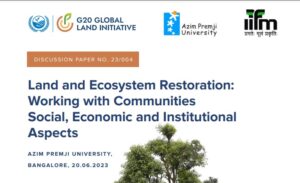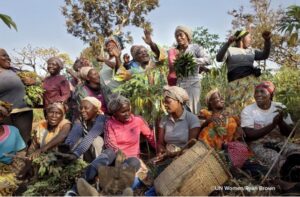
This Discussion Paper was originally published here. It is republished on this website with permissions.
- The Problem:
Habitat modification and degradation is one of the topmost planetary crises. Land use change is a common cause of habitat modification and degradation of terrestrial ecosystems, leading to massive ecological and socio-economic impacts. Additionally, due to unsustainable resource use and agricultural practices, land degradation has caused substantial negative social, economic, and cultural impacts, including human livelihoods, especially in developing economies (Rockstrom et al. 2009; Barbier & Hochard 2018; UNCCD 2022).
Restoration of degraded and modified land thus becomes the closest, essential step to re-create terrestrial ecosystem to its closest natural standards. Being a part of the land, local communities often experience unemployment and substantial economic loss, increasing their dependency on natural resources and land, leading to further degradation. A community-participatory approach towards land restoration and rehabilitation not only enhances ecological attributes but also provides economic incentives to local communities in a sustainable manner. Determining and balancing the outcomes of undertaking land restoration thus become challenging owing to diverse values between stakeholders who often have diverse knowledge and expectations. Hence, it becomes pertinent to investigate the interaction between regional versus local scale and ecological vs. socio-economic players to assess the outcomes of land restoration.
The fourth session of the G20 convention on land restoration focused on community restoration: its approaches and challenges. To this end, the group discussed several community/participatory restoration issues and identified four overarching challenges that were further discussed at the restoration conference held in Bangalore, India, between April 27-29, 2023, to propose recommendations for the G20 collective.
 ©UN Women/Ryan Brown
©UN Women/Ryan Brown
- Restoration challenges
2.1 Lack of representation and recognition:
» Restoration initiatives often work as a top-down process where there is a lack of recognition or inclusivity of local communities. It was felt that although in certain parts of the world, community-driven approaches have been recognized as a policy-driven mandate, this was largely ignored in the rest of the world. Such an exclusionary ‘protectionist approach’ may create negative perceptions regarding the restoration initiatives by local communities.
» In the process, the ingenuity of traditional knowledge is lost during this process. Not every traditional system will be useful or valid, and hence, they need to be validated. However, its outright rejection or loss will mean the disappearance and dispossession of local knowledge production systems from restoration science and practices. Hence, there is a need to document and validate the traditional knowledge available about different ecosystems and communities.
» There is a lack of synergy between the different stakeholder groups that are often noticed. A multistakeholder approach is lacking to bridge the gap between science-policy- and practice.
» Furthermore, equality between the stakeholder group is lacking. For example, unequal representation of gender and caste is often noticed, and a lack of representation of practitioners is evident in the decision-making process.
» A lack of capacity is often an underlying problem that hinders the participation of the larger sectors of the community. In such cases, the community’s participation is under the domination of other stakeholders due to their lower capabilities (financial, management, technical knowledge, etc.)
2.2 Envisioning priorities and goals:
» Often, protection and conservation goals are ignored and/or have a low priority, and hence, ecosystem restoration becomes necessary and unavoidable.
» Often, restoration goals are blurred and over-idealistic and hence, are hard to achieve.
» Often a lack of funds is felt to be the cause of unachievable goals or priorities. Moreover, the available funds are restricted to short-term durations, whereas restoration is a long-term process.
Ensuring the sustainability of these efforts has always been challenging.
2.3 Lack of documentation, evaluation, and decision-making:
» Often there is a lack of universal definitions of terms, concepts and nomenclature. Current definitions are flexible, resulting in shifting goalposts. Additionally, definitions are often based on revenue models and anthropocentric uses. In many developing economies which have been colonized in the recent past, these definitions reflect their history of colonization, and the definitions have not been updated. The terms need to be defined ecologically, which is a major challenge.
» A lack of evaluation and monitoring protocol was identified as a critical challenge. Self-evaluation of the success of restoration needs to be supplemented with independent evaluation and monitoring systems. The evaluation and monitoring should not be only at the project’s end but done throughout. Finally, evaluation and monitoring in the post-restoration phase should be made mandatory, which is often missing. Consistent and persistent implementation of monitoring was also found to be challenging even when good protocols were available.
» The variables defined for successful restoration need to be outcome- and impact-based; however, currently, they are often output-based.
» There is often a huge imbalance between the original ecosystem and the ecosystem of the target; hence, an ecosystem-based community restoration would be crucial. Similarly, a community-need-based restoration practice would be pertinent.
» Often documentation of the restoration approach, action, and monitoring is lacking. Consequently, evidence for methodology and the outcome is missing, and an evidence-based approach to restoration cannot be undertaken. This leads to repeated re-inventions of methodologies and restoration practices.
» Documentation of failures in restoration, as opposed to only success, would be crucial.
2.4 Financing and facilitation:
» Government-introduced legislation, funds, or schemes (particularly in developing countries) are often not properly implemented or distributed. Although there are increasing numbers of innovative financing schemes for community-based activities, these are mostly centered around issues such as climate change, carbon, and nature-based solutions.
» A lack of appropriate and effective legal, regulatory, and institutional frameworks at national and sub-national levels, combined with a lack of understanding and information, hinders the effective disbursement of the funding to the local level and, at the same time, also leads to limited access to the community.
» A lack of external facilitation by NGOs or Community-based organizations is often de-prioritized. Private finance, incentives, and support structures in often unavailable for community restoration practices, unless in privately-owned lands. Although international agencies and private sectors (especially banks/finance houses) play an important role in this regard, the allocation of these resources often lacks clarity.
» The scale of financing and facilitation activities like training and outreach need to be more local rather than only at the regional and national levels.
» Long-term financing needs to be available because restoration is a slow process.
- Recommendations
3.1 Recommendations for G20 Global Land Initiative
- Incentivization of the availability of private and public funds for community-based restoration. This can be achieved by empowering and providing funds to local communities (both rural and urban) for restoration and conservation planning, implementation, monitoring, and participatory action research.
- Facilitating grassroots institutions (both formal and informal) for land restoration, safeguarding against ‘elite capture’ to ensure inclusiveness.
- Working with existing conflict management structures to facilitate resolving conflicts among different land users at the community level to promote land restoration.
- Facilitate and strengthen transparent and adequate documentation of the conservation and restoration procedure and monitoring. This should include community-level documentation to ensure future goalsetting for successful restoration. Further, this should facilitate the dissemination of evidence-based research generated through community-restoration practices.
- Facilitate in identifying gaps and feedback loops for representative community needs through research. Based on that, nationwide training programs on land restoration approaches via promoting hands-on learning. These training programs must be across stakeholder groups to promote cross-disciplinary learning.
- Capacity building, co-learning, and generating young professionals, leaders, local experts, policymakers, and decision-makers.
- As a global restoration platform, G20 could facilitate building a repertoire of universally used terms commonly used in restoration policy and practices.
In a nutshell: G20’s facilitation would be instrumental in connecting key stakeholders, assisting in capacity building, and sharing lessons learned to identify the best practices in land restoration
3.2 General discussions and recommendation points raised during the convention
- All restoration practices should be mindful of the restoration of biodiversity and more importantly, restoration of ecosystem functionality that is best aligned to its original state.
- Community- and ecosystem-need-based restoration practices should be promoted.
- Importance of long-term engagement. Long-term projects with monitoring should be encouraged and facilitated envisioning ecosystem functioning and long-term livelihoods of communities.
- Striking a balance between top-down and bottom-up approaches. Hence, a multi-stakeholder approach to be undertaken where decision-making is not restricted to a few stakeholder groups.
- Funding for land-restoration research should be promoted, in order to identify factors, gaps, and loopholes that determine the success or failures of restoration.
- Policy-based research and participatory research agendas should be promoted that should span across organizations and stakeholders.
- In a community-based restoration, Govt. should have a facilitating role and leave the need-based decision-making to the community.
- The need was felt for an authority (state, NGO, Cybercommunity representatives) that can facilitate the community to make decisions for themselves and resolve inner conflicts.
- There should be a framework that encapsulates the parameters and a constitution for the people to follow.
- It was felt that there is a lack of universal definitions of terms and terminologies that are commonly used in restoration policy and practices. These should be brought to a standardized platform across government policy documents, international organizations, practitioners, and academia.
- The gap between scientific knowledge and traditional knowledge should be bridged by facilitating and incentivising different institutions to work together.
- Involvement of local institutions and organizations to develop need-based restoration frameworks and monitoring protocols.
- Adequate documentation of restoration initiation, action, and monitoring protocol is pertinent to attain successful future initiatives for the optimal utilization of time and money. This should include the detailed documentation of successes and failures in the process of restoring an ecosystem including policy and power issues, challenges in practice, and usefulness of traditional vs. scientific knowledge.
- Capacity and skill building were recognized to be one of the immediate challenges to address in restoration practices. This should be mediated through public or private institutions/ organizations, including academic institutions. This should include skill-building and cross-talks across different stakeholder groups.
- Opportunity building for restoration practice should be done by incentivising young practitioners to work in coalition with different organizations and stakeholders.
 ©UN Women/Ryan Brown
©UN Women/Ryan Brown
- Working group participants and contributors:
Session coordinators:
Alok Bang & Jayanti Ray-Mukherjee
Session participants and contributors:
Alok Bang
Dr Chandrashekhar Biradar
Dicky Pardomuan Simorangkir
Dr. Dandin
Gopi Sankarasubramani
James Tiburcio
Jayanti Ray-Mukherjee
Janny Tri Rahardjo
Madhuri Ramesh
Ramesh Venkataraman
Ronak Shah
Siddharth Rao
Shailendra Tiwari
Sushil Saigal
Syam Vishwanath
Vijay Dhasmana
Yogesh Dubey
References
Aradottir, A. L., & Hagen, D. (2013). Ecological restoration: approaches and impacts on vegetation, soils and society. Advances in Agronomy, 120, 173-222.
Barbier, E. B., & Hochard, J. P. (2018). Land degradation and poverty. Nature Sustainability, 1(11), 623-631.
Moore, E., Howson, P., Grainger, M., Teh, Y. A., & Pfeifer, M. (2022). The role of participatory scenarios in ecological restoration: a systematic map protocol. Environmental Evidence, 11(1), 1-9.
Rockström, J., Steffen, W., Noone, K., Persson, Å., Chapin III, F.S., Lambin, E., Lenton, T.M., Scheffer, M., Folke, C., Schellnhuber, H.J. and Nykvist, B., 2009. Planetary boundaries: exploring the safe operating space for humanity. Ecology and society, 14(2)
Stavi, I., & Lal, R. (2015). Achieving zero net land degradation: challenges and opportunities. Journal of Arid Environments, 112, 44-51.
The Global Environment Facility. Accessed on December 1, 2022. https://www.thegef.org/what-we-do/topics/land-degradation
United Nations Convention to Combat Desertification, 2022. The Global Land Outlook, second edition. UNCCD, Bonn
Urbanska, K. M., Webb, N. R., & Edwards, P. J. (Eds.). (1997). Restoration ecology and sustainable development. Cambridge University Press.
Warner, K., Hamza, M., Oliver-Smith, A., Renaud, F., & Julca, A. (2010). Climate change, environmental degradation and migration. Natural Hazards, 55, 689-715.

